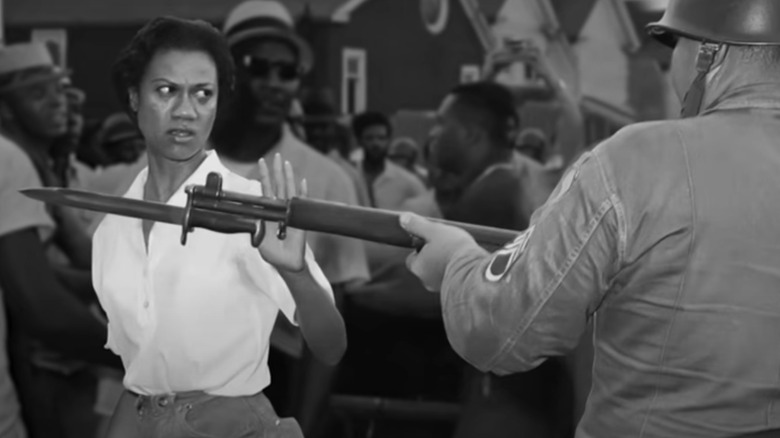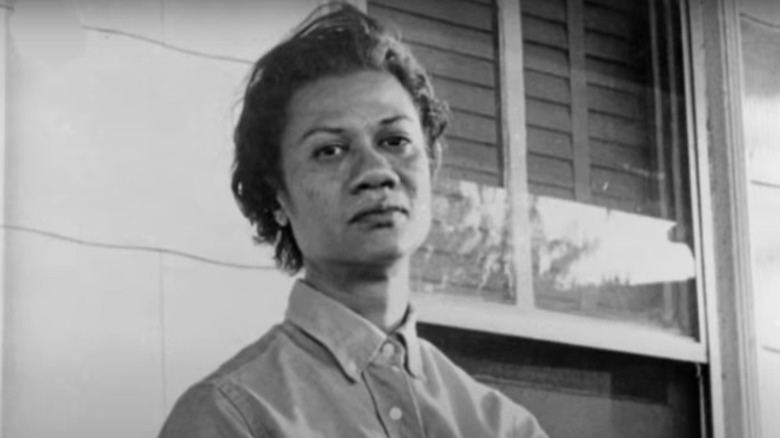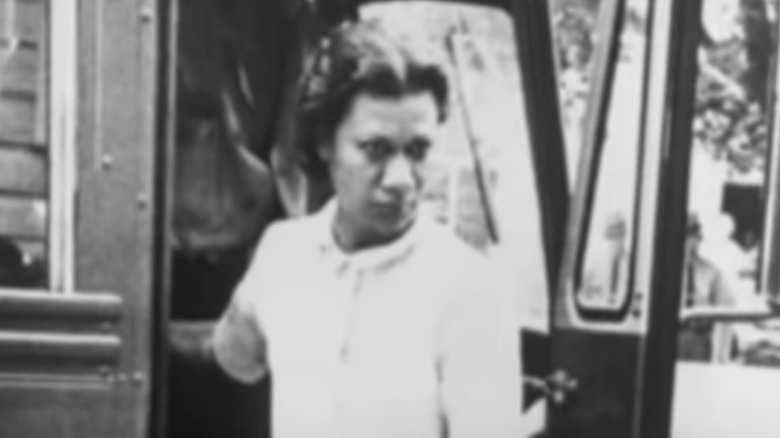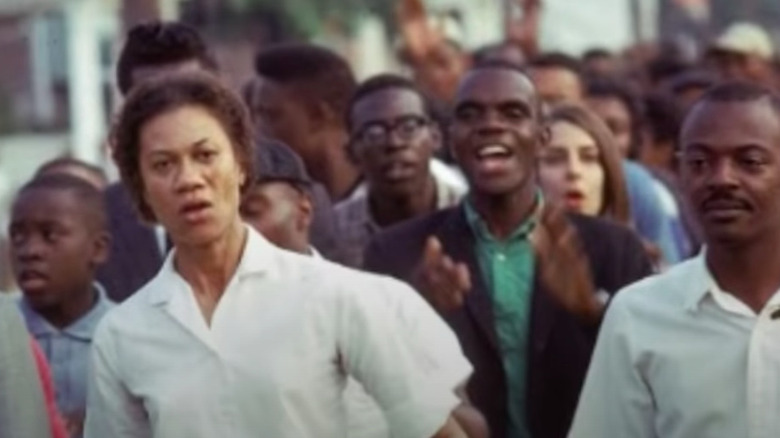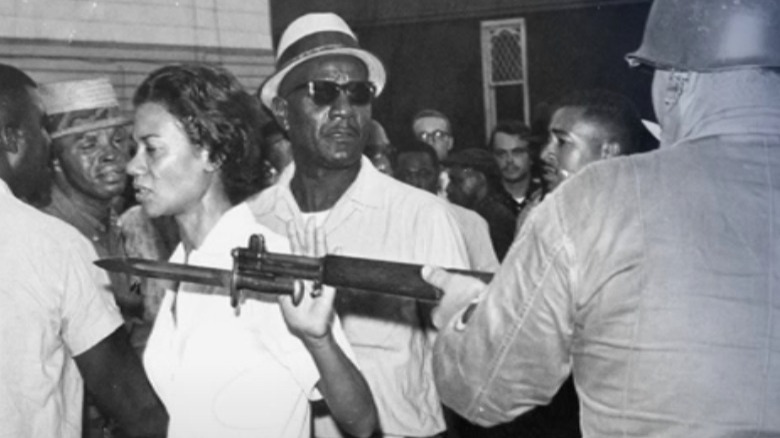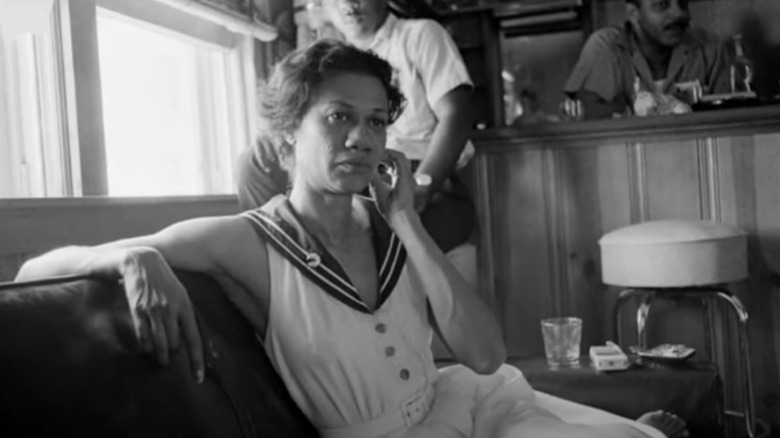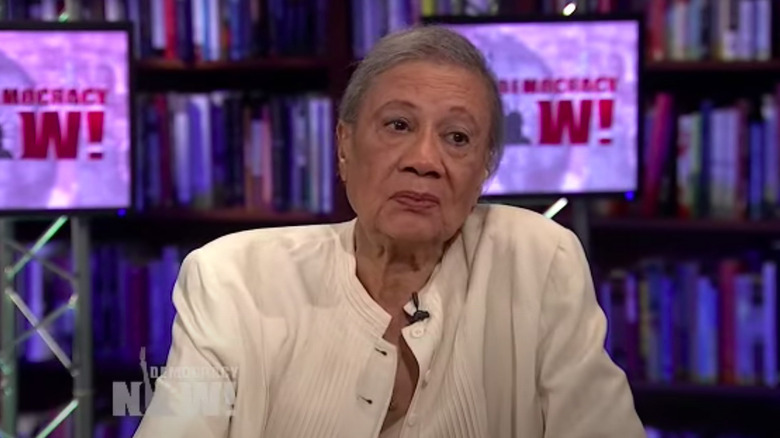The Untold Story Of Gloria Richardson
During the March on Washington for Jobs and Freedom on August 28, 1963, Gloria Richardson was meant to be one of six women speaking as "fighters for freedom." But after being hastily rushed to the stage after being forgotten, all she managed to say was "hello" before her microphone was cut (per The Riveter). In a way, this incident was emblematic of her life as an activist. Even though she was repeatedly told to be less radical, she was unwilling to compromise.
For Richardson, basic human rights weren't something to compromise on. When other activists tried to capitalize from her efforts, Richardson was always ready to shut them down. According to a 1994 interview in Maryland Historical Magazine (posted online at Worklab), during some of her early efforts, Richardson, leading the Cambridge Non-violent Action Committee (CNAC), reached out to Rev. Martin Luther King Jr. for help. She was told that he would visit for a day in a couple of years for a payment of $3,000. But then when the National Guard had gotten involved, King suddenly offered to come. But Richardson and the CNAC considered it "an insult," reported Baltimore Magazine, so they told him, "No thanks, we can handle it ourselves."
Although Richardson's name may not be as well known as Ella Baker or Fannie Lou Hamer, she was incredibly influential in the Civil Rights movement, and was responsible for one of the first prolonged grassroots movements led by a woman outside the Deep South.
Gloria Richardson's early life
Gloria Hayes Richardson was born Gloria St. Clair Hayes to John and Mabel Hayes on May 6, 1922 in Baltimore, Maryland. The family soon moved to Cambridge, Maryland to live with Richardson's maternal grandparents, Herbert Maynadier and Fannie St. Clair. The St. Clairs were a prosperous and wealthy family, and Herbert owned numerous retail properties, including a butcher shop and grocery store, writes Black Past.
Even though Richardson's grandfather Herbert St. Clair was a member of the Cambridge City Council — the first Black member — he still wasn't allowed to attend the same "social events" as his white counterparts, per The Riveter. However, he continued to serve on the city council from 1912 to 1946 and, according to Baltimore Magazine, was "arguably the town's wealthiest and most politically powerful black man."
Richardson's father died from a heart attack when she was young, but his death could have been avoided had there been medical care for Black people near their home. With this experience, Richardson realized that "racism was a matter of life and death." The Student Nonviolent Coordinating Committee (SNCC) writes that the denial of health care caused the early death of Richardson's uncle as well.
Early activism
Richardson left Cambridge to attend Howard University in Washington D.C. at the age of 16. It was there that she first became involved in activism. SNCC writes that at Howard, Richardson was active in protests against segregation at the local Woolworth's. At one point, she was also involved in the protests against conditions at the university.
After graduating in 1942 with a degree in sociology, Richardson tried to get a job with the federal government. Although Richardson worked briefly as a civil servant, even with her degree and her family's connections, not a single agency, including the Maryland Department of Social Services, would hire a Black social worker, writes Black Past. In an interview with Robert Penn Warren (posted at Vanderbilt University), Richardson recounted how even when they were able to find employment, Black people were usually "the last hired and first fired."
As a result, Richardson returned to Cambridge, where she married Harry Richardson. Together, they had two children, but they divorced by the late 1950s. By 1961, Richardson was working at the drugstore owned by her family, and noticing how hard it was for "working-class Black residents of the Second Ward to survive."
Getting involved through her daughter
Richardson became involved with the Student Non-Violent Coordinating Committee (SNCC) through her uncle and her cousin, although it was initially her teenaged daughter Donna and her friends who were recruited. According to an interview in Maryland Historical Magazine, Richardson states that her uncle and her cousin met the SNCC while paying bail bonds for people who had been arrested. When they were told how bad the segregation in Cambridge was, they were convinced to stop there for a bit.
At the time, Richardson was working 12-hour-days at the drugstore, so she recruited her daughter and her teenage friends to act as guides. But before long, Donna was involved in the daily picketing and had become one of the leaders.
The SNCC was involved in desegregation. They held demonstrations and boycotts to "disrupt the local economy," but ultimately Richardson disagreed with their idea of non-violence as a "protest tactic." This led Richardson and other parents to create the Cambridge Nonviolent Action Committee (CNAC) in 1962.
In addition to focusing on desegregation, the CNAC expanded their aims to include "housing and employment discrimination and inadequate health care." And because the CNAC didn't believe in the philosophy of pacifism, their protests were more confrontational, since they fought back when their protests were met with violence, per Baltimore Magazine. One CNAC member claimed, "We are not going to initiate violence. But if we are attacked, we are not going to turn the other cheek."
The Cambridge movement
Led by the SNCC and the CNAC, the Cambridge movement refers to the series of protests in Dorchester County, Maryland that lasted from late 1961 to the summer of 1964. According to Liberation, as CNAC protests targeted segregation in public accommodations, they led Maryland Governor J. Millard Tawes to pass an anti-discrimination bill in 1962. "However, the legislation was rendered useless," reports Liberation, "when racist legislatures inserted a clause allowing counties to simply exempt themselves from the law."
CNAC protests continued into the summer of 1963. Although Governor Tawes made promises of desegregation and biracial committees, his proposals were rejected by the CNAC, who didn't trust the governor. Baltimore Magazine writes that as the protests started escalating into face-offs involving Molotov cocktails and bricks, even Richardson advocated federal intervention. Sending a telegram to U.S. Attorney General Robert Kennedy, Richardson wrote, "I emphasize that violence has and most likely will occur."
On June 14, 1963, Governor Tawes declared martial law. The National Guard was brought into Cambridge, and would remain there until July 8. But the violence continued to escalate during their absence, and by July 12, the National Guard returned. Ultimately, this would be "the longest martial law deployment in the United States since 1877," as Liberation characterized it.
The Treaty of Cambridge
During the summer of 1963, Richardson met with Attorney General Robert F. Kennedy to discuss terms that might "diffuse the situation." With negotiations that also included officials from the Justice Department, CNAC leaders, and SNCC chairman John Lewis, per Baltimore Magazine, after nine hours they finally came to an agreement, which included desegregation of the first four grades of Dorchester County primary schools and an amendment for the desegregation of public accommodations.
However, the agreement noticed that it could still be subject to a referendum, which led Richardson to cautiously describe the agreement as "an initial step" rather than a victory. Meanwhile, Kennedy noted Richardson's serious demeanor, asking her, "Do you know how to smile?"
Liberation writes that the Treaty of Cambridge was signed on July 23, 1963, and just as Richardson feared, the amendment was made subject to an October referendum. As a pro-segregation group urged white people to vote no on the amendment, SNCC writes that Richardson encouraged a boycott of the referendum altogether, explaining that "A first-class citizen does not beg for freedom. A first-class citizen does not plead to the white power-structure to give him something that the whites have no power to give or take away. Human rights are human rights, not white rights." Unfortunately, the amendment ended up being defeated. But the momentum was already there, and despite the efforts of pro-segregation groups, by July 1964, several businesses were desegregated, and the National Guard finally left Cambridge.
Richardson's later life
By the end of the summer of 1964, Richardson decided to take a step back from the CNAC's work. In August, 1964, she resigned as the chairman of the CNAC. She married photographer Frank Dandridge and moved to New York with Richardson's younger daughter, Tamara. There Richardson got a job at the Department of Aging, writes Baltimore Magazine. Ebony Magazine notes by the time Richardson resigned, she had been arrested three times, shot at twice, and "there had been two attempts to have her committed because whites thought her insane."
In New York City, Richardson went on to work at the National Council of Negro Women as an assistant director, focusing her energy on achieving equality for Black women. According to Black Past, Richardson never moved back to live in Cambridge again, although she maintained a connection with the local movement there. Richardson continued to work until retiring in 2012, at the age of 90, per The Washington Post. On July 15, 2021, Richardson passed away at the age of 99.
